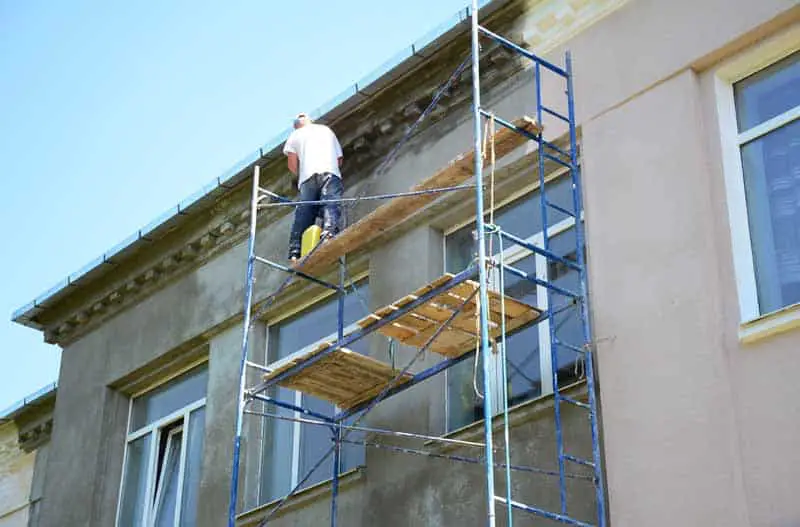
If you’re considering using limewash on your exterior render or masonry surfaces, you may wonder if it will wash off in the rain. If properly applied, limewash should not come off in the rain. Once cured, limewash will provide a durable finish that can withstand the elements. However, there are some factors to consider when it comes to the longevity of your limewash finish.
Remember that limewash will weather and patina over time, creating a beautiful aged look. So while it may not wash off in the rain, it will likely wear away gradually over the years. A touch-up or a new coat every three to seven years is recommended. Additionally, the quality of your limewash application can impact its durability. If the limewash is applied too thickly or unevenly, it may be more prone to wear and erosion.
When it comes to maintaining your limewash finish, it’s important to avoid harsh cleaning methods or chemicals that could damage the surface. Instead, opt for gentle cleaning methods. These include gently wiping with a damp cloth or soft brush to keep your limewash looking its best. With proper care and maintenance, limewash can provide a timeless, eco-friendly finish that adds curb appeal to any home.
What is Limewash?
If you’re looking for a unique and eco-friendly way to give your home’s interior or exterior a new look, limewash might be just what you need. Limewash is a traditional paint made from lime putty and water that has been used for centuries. It is a versatile material that can be applied to various porous surfaces, including masonry, lime plaster and lime render.
One of the main benefits of limewash is its breathability. Unlike cement or other modern paints, limewash allows surfaces to breathe, preventing moisture buildup and mould growth. This makes it an excellent choice for interior and exterior surfaces, especially in humid environments.
Limewash is also an eco-friendly option as it is made from natural materials and does not contain harmful chemicals. It is an excellent choice for environmentally conscious people who want to reduce their environmental impact.
When it comes to application, limewash is best suited for porous surfaces. It can be applied with a brush or, in some cases, a sprayer. Typically 3-4 coats will be required to build up a suitable depth of colour and coverage. Luckily, limewash itself is very cheap compared to modern paints.
Overall, limewash is an excellent choice for those looking for a traditional, eco-friendly alternative to modern paint. It is breathable, durable, and versatile, making it suitable for a range of surfaces both inside and outside your home.
Related article: What is Limewash? An Overview of This Traditional Paint
Does Limewash Wash Off in Rain?
If you’re considering using limewash on your outdoor walls, you might wonder if it will wash off in the rain. The answer is not a straightforward yes or no.
When properly applied, limewash can withstand rain and protect the surface it has been applied to. However, limewash will weather and patina over time, creating a beautiful aged look. So while it won’t necessarily wash off in the rain, it may eventually wear away over many years. If your limewash looks a bit old, you can simply apply one or two new coats to freshen it up.
To ensure that your limewash is as weather-resistant as possible, it’s important to apply it correctly. Limewash must be applied in very thin coats (it will look translucent, to begin with) and kept damp as it cures. The limewash should dry very slowly over the course of 24 hours to allow it to carbonate properly.
If it’s drying too quickly, use a mist strayer and gently mist the surface. Alternately, hang damp hessian sheeting (or other damp sheeting) in front of the limewashed surface. This helps to slow the drying. As it carbonates slowly, limewash hardens, forming a good bond with the substrate.
It’s also worth noting that the weather can affect how well limewash adheres to surfaces. If you’re in a humid environment, it may take longer for your limewash to cure and harden. This makes it more susceptible to washing off in rain before it can cure fully.
Overall, limewash is a durable and low-maintenance option for outdoor walls. With proper application and fresh coats as needed, limewash can provide a beautiful finish for years to come.

How to Clean Limewash
Cleaning limewash is a straightforward process. However, it is essential to follow the correct steps to avoid damaging the coating. Here is a step-by-step guide on how to clean limewash:
- Remove dirt and debris: Start by removing any dirt or debris on the surface of the limewash. You can use a soft-bristled brush or a vacuum cleaner to do this. Ensure you do not use a high-pressure washer, which can damage the coating.
- Remove stains: If there are any stains on the limewash, you can gently wipe the surface with a slightly damp cloth. If the stain is persistent, your best bet would be to touch up the area with fresh limewash or apply a new coat to the wall in question.
- Touch-ups: If there are any areas where the limewash cannot be properly washed, you can do touch-ups. Apply fresh limewash to the area that requires touching up. You may need to blend it with the older limewash. Alternatively, you can give the whole wall a freshen-up with new limewash; this way, no blending will be required. Additionally, adding fresh coats every few years will help the limewash remain durable and protect the surface it’s been applied to for many more years.
Related article: How Long Limewash Lasts & How Often it Should Be Reapplied
Considerations When Applying Limewash
When applying limewash to your walls, there are a few important considerations to remember. First and foremost, avoiding applying limewash in rainy weather is essential. If you apply limewash during a rainy period, the rain can wash away the limewash before it has a chance to cure properly. This can lead to a patchy, uneven finish. You will probably need to reapply the limewash to achieve the desired result.
Another factor to consider when applying limewash is the temperature. Limewash should not be applied in extreme heat or cold below 5 Celsius. This can cause the limewash to dry too quickly or won’t cure at all if it’s too cold. If the limewash dries too quickly, it can crack or flake. While if it is too cold, it may not set properly.
You should also avoid applying limewash in harsh drying winds. This can cause the limewash to dry too quickly, leading to cracking and flaking. If you must apply limewash in windy conditions, it is recommended that you hang damp hessian sheeting in front of the limewashed wall to help break the wind.
Before applying limewash to your walls, it is important to ensure the surface is clean and free of any dirt, dust, oils, grease or debris. This will help to ensure that the limewash adheres properly to the surface and that the finish is smooth and even.
Finally, avoiding scrubbing or washing the limewash would be best, as this can cause the surface to thin prematurely. You can try to wipe the surface with a mildly damp cloth gently. If the surface doesn’t clean to your satisfaction, a new coat of limewash may be required.
Related article: What Surfaces Can Limewash be Used on? A Comprehensive Guide
Conclusion
In conclusion, limewash is a durable material that can be used on outdoor and indoor surfaces. If applied properly, it will not come off in rain. However, it is important to note that limewash will weather and patina over time. If it’s looking particularly weathered, a fresh coat of limewash may be all the surface needs to look great again.
To ensure that your limewash does not come off in the rain, it is important to apply it properly and allow it to cure slowly over the course of 24 hours.
Overall, limewash is a beautiful and durable material that can add character and charm to any home. With proper application and care, it can withstand the elements and provide a long-lasting finish.

